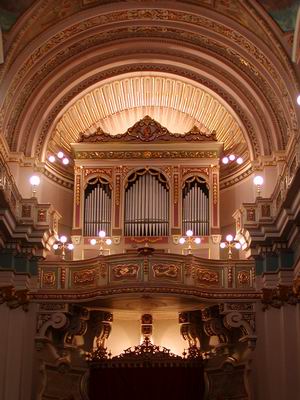 |
|
 |
Cav. P. Inzoli 1922
View Photo Gallery
 |  |  |  |  |  | | Organ case and facade after restoration |
|  |  |
The organ in Siggiewi parish church is a 2-manual, 15 stop tubular pneumatic organ with cone-valve chests housed in an elegant case. Some time after its installation Inzoli added a reed Voce Umana 8’ on a new cone chest within the swell box. This was not a very successful job since this stop is almost unreachable for tuning. Tonally, the organ is beautiful and well-planned according to the then current voicing fashion. Unfortunately the pneumatic action was always the weak point of this organ.
When the organ was inspected prior to the restoration it was in a very bad state. The chests were faulty and much of the lead tubing had been damaged. The organ was only just playable – the pedals were totally out of action.
The restoration started in 1998 and was completed in 1999. It was decided to maintain the original structure (tonal and pneumatic action) of the organ even though the action is not a fine one.
All the various pneumatic parts within the organ and console were dismantled, repaired and regulated. All puffers (about 1200) were replaced. The double-rise bellows was completely releathered from the inside since it could not be extracted. New tubing was installed to replace the old damaged one though all the old good lead tubing was retained.
All the pneumatic controls in the console were returned to life including a very complex and fragile keyboard piston combination system which also acts as a crescendo system.
A good deal of time was used to regulate the action as accurately as possible to improve the action. This proved to be very rewarding since the restored action is extremely better.
The cone chests were opened and the cone valves verified one by one. Quite a number of valves had broken guides and were therefore prone to ciphering. There were also cracks in the wood which caused soft ciphers. These problems were all addressed successfully. The channels were resealed with paper (as originally) before the toeboards were replaced.
New trunking was constructed to connect the blower to the bellows. A new regulating valve and a non-return valve were also installed. Unfortunately the original manual blowing system with cuneiform pumps (2 or 3 pumps) had been removed and lost. However the large iron wheel which moves the pump mechanism still survives.
The pipework required much attention. All pipes were cleaned and then repaired. Most open pipes had severely damaged tuning slots. The wooden pipes in the pedal section required much work too. A lot of challenging but rewarding work was required to get the Tromba 8’ back to life.
The final part of the restoration was the voicing and tuning. Voicing was carried out with respect to the original voicing characteristics. The organ was then tuned in equal temperament.
Stop list| Great | Swell (enclosed) | Pedal | Principale 8’
Dulciana 8’
Undamaris 8’
Ottava 4’
XV 2’
Ripieno 4file
Tromba 8’ (reed) | Bordone 8’
Viola 8’
Flauto 4’
Concerto Viole 2 file
Voce Umana 8’ (reed) | Contrabasso 16(open)
Basso 8’
Bordone 16’ |
Couplers
Great to Pedal, Swell to Pedal, Swell to Great, Great Octave, Swell to Great Sub-Octave
Accessories
4 keyboard pistons on the Great
3 keyboard pistons on the Swell
Pedal levers for all couplers, FORTE, and ESPRESSIONE
(When the Espressione pedal lever is depressed the Swell pedal becomes also a Crescendo pedal)
Keyboards : 58 notes (C1-A58)
Pedal : 27 notes (C1-D27)
|